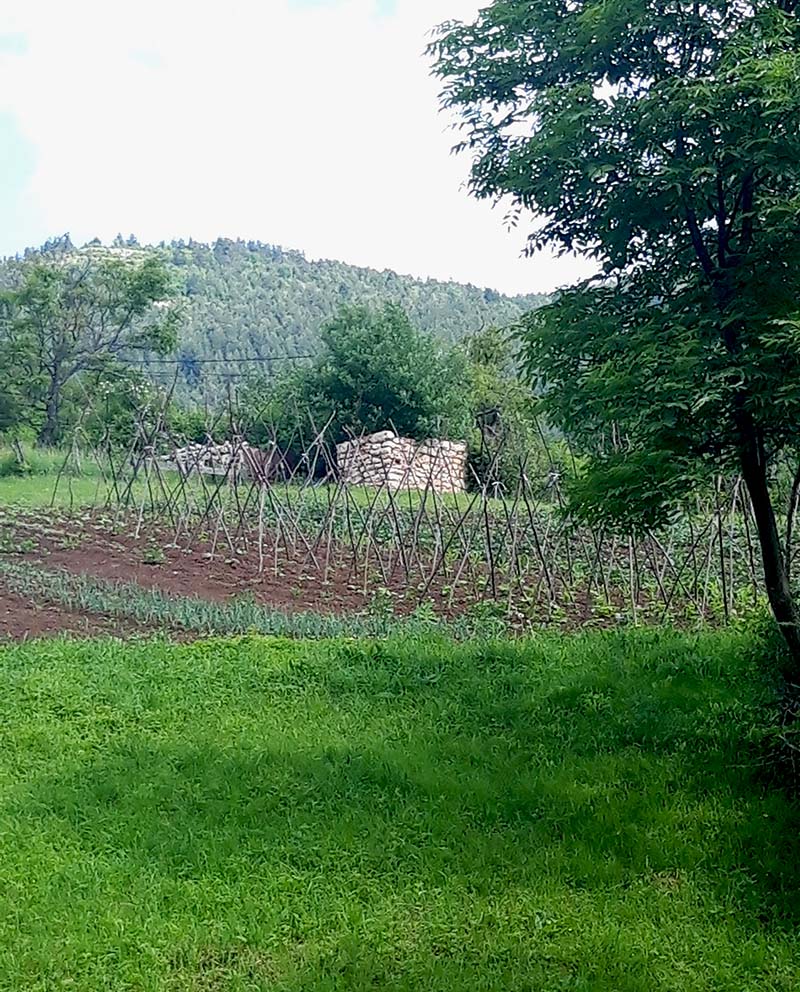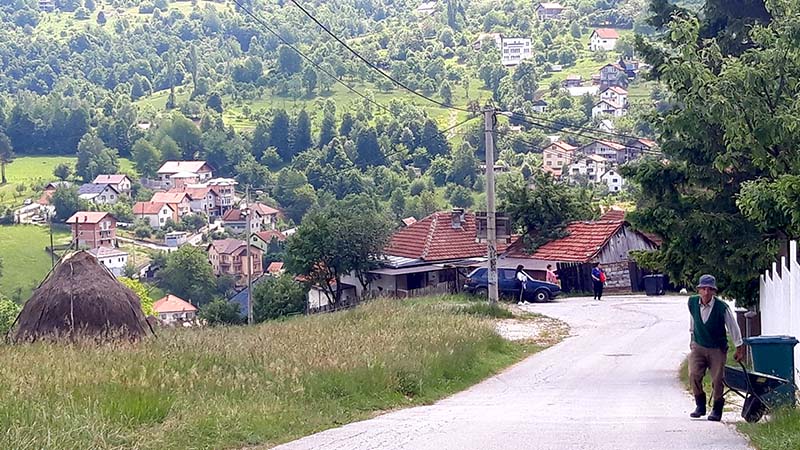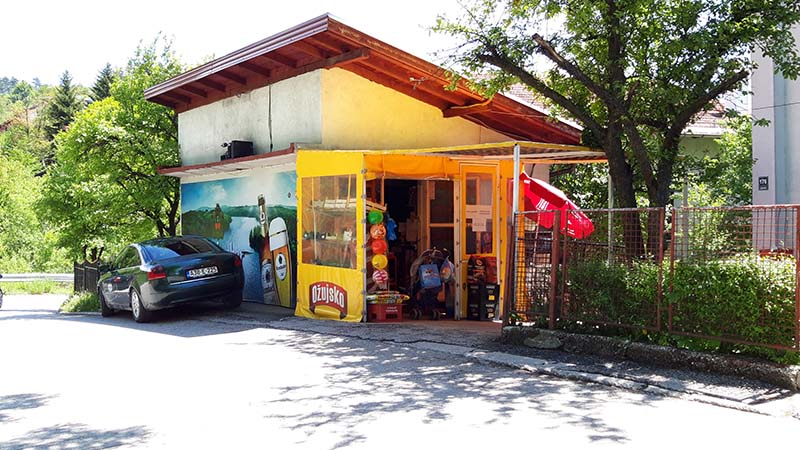“We go out into the open area since it is too cold in the shade. I devour the landscape. Life has conditioned me for such a gaze; I cannot do anything about it. Even the washing on the edge of the stream evokes for me the commemoration of the birth of the landscape. However, can we doubt that these people, in their own way, had and still have a profound sense of the landscape?” (Thinking through landscape, Augustin Berque, 2013)
This is the second part of my first spring walk in Sarajevo, following a path leading to Sedrenik and Barice, and if you continue up further to Čavaljak. These are locations that are predilection outings for city dwellers in the weekend. This time I was back up on the main road of the Sedrenik village, from where I took Sedrenik Mali, a street getting narrower with each footstep, to finally transforming into a steep stony path, weaving in and out of dense woods and clear plains alternatively. Looking at the surroundings, I could discern the Ravne Bakije’s cemetery I came across on my first walk. After standing on a flat vantage point, I found myself amid high poplars and pine trees again. A soft light filtered, and birds were chirping. I was alone, and I felt this uncanny sensation woods deliver, of safety but also estrangement. Soon I reached a fenced enclosure bordering the park called Šuma Priljateljstva. It was closed; some kiosks at the beginning and folded sunshades near an ice cream spot testified of a public usually coming with kids to enjoy the facilities of the “natural” park.





Leaving the park behind, I continued along a road cutting through plains extending on each side. Few houses are scattered among these wide stretches of verdant grass. The panorama: thick strips of trees, a superposition of hilltops, and ultimately the mountains closing the perspective… a stratification of the “factual” environment, as Berque would call it.
“Landscape is not the environment. The environment is the factual aspect of a milieu: that is, of the relationship that links a society with space and with nature. Landscape is the sensible aspect of that relationship. It thus relies on a collective form of subjectivity.” (Beyond the modern landscape, Augustin Berque, AA Files, No. 25, Summer 1993, pp. 33-37).
I am curious to know how this sensibility is expressed in Bosnia, this particular response to the environment. What is their understanding of landscape? This environment is very complex: land politics have successively shifted regime. The vakuf system that determined all land property aspects and shaped the territory during the four centuries of Ottoman rule was successively reformed under Austro-Hungarian, Kingdom of Serbs, Croats and Slavs, kingdom of Yugoslavia and Tito’s Yugoslavia. How did all these changes affect public and cultivated land, as well as urban institutions translate into the perception of the territory?


While meddling with these thoughts, I reached a panel entitled Barice od broja 23 do 33, indicating the postal number of the few houses at the beginning of the footpath, going down through the valley to reach Donje Biosko. I followed the rocky tracing. The prairies, the neatly divided cultivation and grazing plots, the flock of goats and the smell of manure; gave way to small houses on both sides of the bumpy path, henhouses, beehives, greenhouses, beautifully aligned furrows, suspicious dogs… It was curious for me to find this ambiance at one hour and a half from Sarajevo’s bustling urban centre.
Then, and probably triggered by some fruit trees on my way, I remembered when Lopakhin wants to cut down the cherry orchard in Chekhov’s play.
Lopakhin: […] But, of course, the place will have to be pulled down, as well as this house which is no good to anybody. The old cherry orchard should be cut down, too.
Liubov Andryeevna: Cut down? My dear man, forgive me, you don’t seem to understand. If there’s one thing interesting, one thing really outstanding in the whole county, it’s our cherry orchard.
Lopakhin: The only outstanding thing about this orchard is that it’s very large. It only produces a crop every other year, and then there’s nobody to buy it.
Gayev: This orchard is actually mentioned in the Encyclopaedia.
Lopakhin [glancing at his watch]: If you can’t think clearly about it, or come to a decision, the cherry orchard and the whole estate as well will be sold by auction. You must decide! There is no other way out, I assure you. There’s no other way.
Feers: In the old days, forty or fifty years ago, the cherries were dried, preserved, marinated, made into jam, and sometimes…
Gayev: Be quiet, Feers.
Feers: And sometimes, whole cartloads of dried cherries were sent to Moscow and Kharkov. The money they fetched! And the dried cherries in those days were soft, juicy, sweet, tasty….They knew how to do it then…they had a recipe…
Liubov Andryeevna: And where is that recipe now?
Feers: Forgotten. No one can remember it.
Thank god, nobody is thinking of selling off the orchards of Sarajevo’s surroundings for “building villas, these calculations about summer residents […]” yet. (The cherry Orchard, Anton Chekhov, 1903)





While walking, I think of this relation between nature, and the artifice of cultivating and processing products that becomes in a way who we are. Cherry jam, the nature is mediated. Then the paradise is lost: like the recipe… The environment constitutes more than means of production and transforms in a raison d’être in the world, a culture: “it is the only thing that matters in the whole wide world” and “The orchard figures in the encyclopaedia”. The birth of a landscape? At least Liubov Andryeevna has developed what Berque’s describes as essential to a landscape’s birth “the sensible aspect of that relationship” to the environment: “Oh my darling, my precious, my beautiful orchard! My life, my youth, my happiness…good-bye!…good-bye!”
My interpretation of course; my questioning about landscape versus environment, in the light of the sceneries deploying in front of me.
I reach Hladivode, I was looking forward to see the structure of the Hladivode Rezervoar, but nothing in sight. Probably is it behind a wall fenced area I spotted on entering the village? Houses were popping on each side of the road, always adorned with colourful flowerpots. I even saw two garden dwarfs intentionally positioned to have the best vista at the surroundings, as to insist on the magical effect of the scenery. The public bus reaches Hladivode; his last stop, on one side of the steep narrow road, allows the minimal space for a u turn to go down the hill again towards the city. Its presence positions Hladivode in the very limit of the city. The quietness is only disturbed by the grinding of a bike dragged uphill by a shy child. A table with a chair under a big tree reminds of the simple pleasures of life.



I was reaching the end of my sketched journey. The ascent movement of the beginning was giving place to an agreeable slow descent. Down along Baruthana street, I see two persons leaning graciously over cultivation furrows inserted in between the houses. I don’t know why but it is a comforting image, probably for a city dweller, to see that we haven’t completely lost our relation to land. I reach Sarajevskih Ghazija, a road marking the limits of a hilltop and therefore providing amazing views. I am probably looking at the Obhodža village on the opposite hilltop. Down in the valley I see a pedestrian path sneaking in between the trees; where could it lead? I have to check it. In the distance, the swirls of the highway R447, tunnels and bridges are like gigantic worms perforating the mountains, to make way through the hilly topography. I reach Višegrad gate again, the point of departure of the walk.
Pejzaž is the Bosnian word to refer to landscape, probably inherited from paysage, paesaggio. A visit to the Zmelajsiki Museum is necessary to further enlighten me on the Bosnian sensible and subjective relation to the environment; while I prepare for the next walk.




